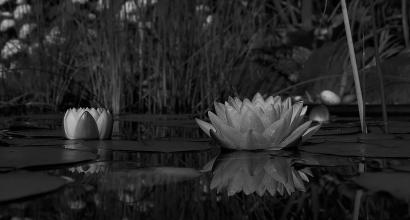Family Lineage
Srikanta Sastri’s family history deserves to be mentioned here.
Several among Sastri’s ancestors were eminent scholars; they had attained excellence in music and literature and were spiritually inclined[1]. For several of them, it may be said that knowledge of Sanskrit and enthusiasm for music, theatre, dance, and other arts was in their blood. The accomplishment of those ancestors and the treatises that they composed has today largely become a matter of conjecture [i.e. it has been swept away by time]. One of the reasons for this is the lack of widespread printing technology during their times. (Yet another reason is that a historian and chronicler like Srikanta Sastri didn’t exist then!) An even more important reason is that his ancestors were the sort of people who worked for self-satisfaction and not with any other desires.
This mindset of detachment was common among the yesteryear scholars. Therefore it is not surprising that the literary works composed by Sastri’s ancestors were destroyed; what is surprising is that a few treatises as well as bits and pieces of a few works have remained, somehow escaping the ravages of time. Among those ancestors, ‘Abhinava-Kālidāsa’ (‘New Age Kālidāsa’) was a famous personage.
Srikanta Satri’s origins are in Andhra; he belonged to the Telugu-speaking Mulakanāḍu community. Mid-sixteenth century onwards, hundreds of Mulakanāḍu families moved to the South in search of livelihood and partly to escape onslaughts of the oppressive Muslim rule. The members of this clan settled down in regions near Bangalore including Nèlamaṅgala and Māgaḍi as well as in places like Prasthapuri (Ballapura), Kakudgiri (Shivaganga), Srirangapatna, Dharmapuri, and so forth.
Among the families that settled in and around Nèlamaṅgala, one of the eminent ancestors was Mudduvèṅkaṭeśvara Somayāji; he was ten generations before Srikanta Sastri. After Abhinava-Kālidāsa, from what is known and remembered of the lineage, we can consider this Somayāji as the root of the family tree of Srikanta Sastri and the Moṭagānahaḻḻi scholars. He lived in the second half of the seventeenth century. In that family tree, the branch that corresponds to Sastri is the following – Mudduvèṅkaṭeśvara Somayāji → Yajñapati Somayāji → Nārāyaṇa Somayāji → Kṛṣṇadīkṣita → Gaṅgādhara-śāstrī → Vèṅkaṭakṛṣṇa-śāstrī → Nañjuṇḍa-śāstrī → Rāmasvāmi-śāstrī → S Srikanta Sastri.[2]
The residences of these families were in Sòṇḍekòppa, Moṭagānahaḻḻi, Māgaḍi, Tirumalapura, Bherikè (Bhairanahalli), and so on. (It was Bhāskarapanta Subbanarasiṃha-śāstrī who in the 1940s painstakingly explored and drew out the details of this family tree.)
Srikanta Sastri’s grandfather Sòṇḍekòppa Nañjuṇḍa-śāstrī had two brothers – Nārāyaṇa-śāstrī and Gaṅgādhara-śāstrī, both of whom were erudite scholars. He was a contemporary and associate of the far-famed Tarka-śāstra exponent Kunigal Rāma-śāstrī[3], along with whom he travelled to the prominent education centres of the State and participated in vidvad-goṣṭhis with several scholars. Moṭagānahaḻḻi Mahādeva-śāstrī and ‘Āsthāna-vidvān’ Śaṅkara-śāstrī were both disciples of Nārāyaṇa-śāstrī and Gaṅgādhara-śāstrī.
Sòṇḍekòppa is around twenty-two miles from Bangalore. To the northeast of Bangalore, on the Bangalore-Tumkur highway, there is an internal road that goes from Nèlamaṅgala to Tāvarekèrè. If one were to travel five or six miles on that inner road one would come upon the village of Sòṇḍekòppa. For a long time, Sòṇḍekòppa has had transactional, marital, and such-like relations with Nèlamaṅgala, Tāvarekèrè, Moṭagānahaḻḻi, Māgaḍi, Bangalore, and other places.
Sastri’s ancestors lived in conditions which today would be described as near-poverty. They managed to survive by learning-related hackwork, peripherally supplemented by nominal agriculture.
In early-seventeenth century ce, Kempegowda II had gifted some lands near Nèlamaṅgala to one of Sastri’s ancestors, Yajñapatibhaṭṭa or Yajñambhaṭṭa, for his livelihood.
‘Kempegowdarayya II, who was the son of Kempegowdarayya and grandson of the Chief of Yalahaṅkā, hailing from the Caturtha gotra, Kempanache Gowdarayya, had gifted lands to Yajñambhaṭṭa of the Kāśyapa gotra and Āpastamba-sūtra.’ That ‘bhūdāna dharma-śāsana’ was preserved in Srikanta Sastri’s house.
Ten generations after the grant was given, by the time of Sòṇḍekòppa Rāmasvāmi-śāstrī (d. 1935), i.e. Srikanta’s Sastri’s father, the land that remained was around twelve acres in Sòṇḍekòppa and in the neighbouring villages of Irigenahaḻḻi and Maṃṭanakurci. The produce from the ancestral lands was nothing to boast about. The family condition saw some betterment only after Rāmasvāmi-śāstrī joined government service in Mysore. He served as a Sub-registrar in Nanjangud, Chikkaballapur, Kolar, and other places before retiring in 1919. It was during his tenure in Nanjangud that Srikanta Sastri was born, on 5th November 1904, as the second of seven children. Srikanta Sastri’s mother was Śeṣamma.[4]
We can now discuss about the cultivation of literature undertaken by Srikanta Sastri’s ancestors.
Literary Lineage
The Śrī Rāmeśvara Temple in Chamarajpet, Bangalore was built in 1905. Since then, for tens of years, every evening the Vèllāḻa brothers (Moṭagānahaḻḻi Mahādeva-śāstrī, his younger brother Śaṅkara-śāstrī, and his youngest brother Rāmaśeṣa-śāstrī), who lived near the temple and many other scholars would assemble in time for the dīpārādhanā. During the mantra-puṣpa-sevā, when the arcaka would say, “Stotra-pāṭham-avadhāraya,” either Śaṅkara-śāstrī or Rāmaśeṣa-śāstrī would sing a śloka set to a rāga. We’ve heard that there were two ślokas that the brothers would sing time and again – one was a Gaṇeśa-stuti, ‘Sānandaṃ nandi-hastāhata…,’ which is the maṅgala-padya of Mālatī Mādhava [of Bhavabhūti] and the other was the following Devī-stuti in the Sragdharā metre –
kalyaṇaṃ naḥ prabhūtam kalayatu lalitālāpa-śaileśa-bālā
līlā-jālānukūlā śiśira-kara-kalā bhānu-mālā jaṭālā।
eṣā śeṣāhi-bhūṣā parikalita-sudhāpūra-dhārānukārā
bhadrā-mudrā vinidrā pura-haraṇa-vidhau kāpi kāruṇya-pūrṇā॥
May Pārvatī secure our welfare!
Her words are sweet and she revels in the sport of nourishing the universe.
A radiant crescent moon adorns her locks; ādiśeṣa embellishes her.
She is the embodiment of a stream of amṛta.
She is full of compassion and sports a gesture of good fortune.
She is ever-vigilant in vanquishing the Tripura demons.[5]
This is the maṅgala-padya of Abhinava-Kālidāsa’s poetical work, Bhāgavata-campū, composed in mid-fifteenth century. All through the work we find a similar poetic style with several alliterations. It has an ornate and scholarly style. In sum, it appears to be a poetical work that was composed for vidvad-rasikas.
‘Abhinava-Kālidāsa’ was a maternal ancestor of Srikanta Sastri. It appears that his real name was Umāmaheśvara-śastri or Umāmaheśvara-somayāji. He lived in an era before the sixteenth century and was a poet in the court of Devarāya II of the Vijayanagara Empire.
This campū treatise, which summarizes the most important episodes and segments of the Bhāgavata-purāṇa, is composed in six ‘vilāsa’-s[6] and contains hundreds of beautiful descriptions and passages. At the start of the work there is a statement that promises ‘Prati-padam-dhvaner-jṛmbhaṇam’ – ‘Every word will resonate with dhvani.’[7] There are lovely ślokas sung by the devatās as well as Nārada and other ṛṣis in praise of the Supreme One who is ‘Devakī-garbha-bhavanādivāsa’ [‘Dweller in the home that is Devakī’s womb’] and ‘Viśva-santrāṇa-cetasa’ [‘The spirit that protects the universe.’]
Among Sastri’s ancestors, many of them had the hobby of composing stotras and songs. They neither had the desire nor felt the necessity to write down these compositions. And so, what came down from father to son, from mother to daughter, in an oral tradition, and the few compositions that remained on the tongues of the descendants is all that is left of the family environment of the bygone era and serves as a faint memory of the scholarly toil of his ancestors.
Srikanta Sastri’s mother, grandmother, and other elders had on the tips of their tongues hundreds of stotras and songs composed by their ancestors in Sanskrit, Kannada, and Telugu. The composer of several of these compositions is unknown. One Rāmacandra-śāstrī composed Vighneśa-stava, Dakṣiṇāmurtyāṣṭaka, Lalitā-nava-ratna-mālikā, and other works. Candraśekhara-śāstrī (or multiple people with that name) composed Gaṅgāṣṭaka, Girijā-stuti, and so forth.
To be continued...
This is the second part of a five-part English adaptation of 'Nadoja' S R Ramaswamy’s article on Prof. S Srikanta Sastri and the Moṭagānahaḻḻi Scholarly Lineage (pp. 184–207) in his anthology Dīvaṭigègaḻu (Bangalore: Sahitya Sindhu Prakashana, 2012) with additional points taken from a paper titled ‘Professor S. Srikantha Sastri: A Brief Biographical Memoir’ that he presented at the two-day birth centenary seminar on Sastri organized by the Mythic Society, Bangalore, on 20th and 21st November 2004. Thanks to Dr. S R Ramaswamy, Śatāvadhānī Dr. R Ganesh, Prof. L V Shanthakumari, and Arjun Bharadwaj for their thorough review and invaluable suggestions for improvement.
Footnotes
[1] The original has ‘adhyātma-niṣṭharu.’
[2] The author’s father Sri. S Ramachandra Sastri was Dr. S Srikanta Sastri’s younger brother. (The author’s mother’s name was Smt. Saraswathamma.)
[3] A renowned scholar who flourished in the court of Krishnaraja Wodeyar III in the mid-nineteenth century.
[4] She predeceased her husband by over two decades.
[5] All Sanskrit and Kannada verses that appear in this essay have been translated into English by Śatāvadhāni Dr. R Ganesh and B N Shashi Kiran.
[6] The word ‘vilāsa’ means ‘enjoyment’ but here it refers to ‘chapter’ or ‘canto.’
[7] There appears to be a pun on the word ‘dhvani,’ which means both [mellifluous] ‘sound’ as well as ‘poetic suggestion.’











































